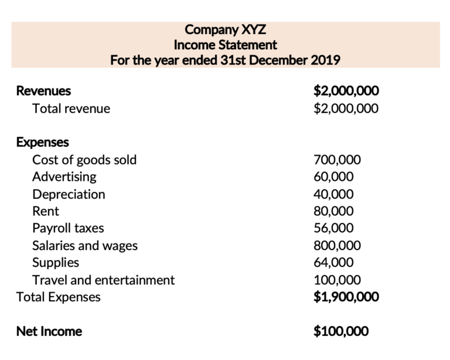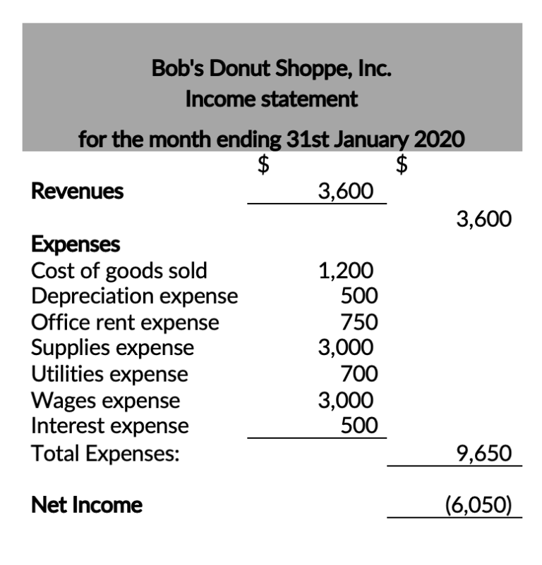A single-step income statement is a format in which all of the expenses, including the cost of goods sold, are listed in one column. Put simply, a single-step income statement does not separate the expenses into categories like the cost of goods sold, operating expenses, non-operating expenses, or other expenses.
A company’s income statement will show the revenues, expenses, and profit or losses in a financial period. The financial period of a company can vary from being monthly, quarterly, or semiannually to even a full year.
A multi-step income statement format is more suitable for larger organizations that sell tangible goods. A single-step income statement will mostly be used by smaller companies such as sole proprietorships, service-based companies, and partnerships.
Single-Step Income Statement Template
Throughout this series of financial statements, you can download the Excel template below for free to see how Bob’s Donut Shoppe uses the income statement (and others) to evaluate the performance of his business.
Format and Preparation
The single-step format will have two broad categories: revenues and expenses.
The revenue category will come first or right at the top and there is only one subtotal for each category. All the revenues including service revenue, consulting fees, investment income, etc. will be listed together under this one.
The second category relating to expenses will appear right below the revenue category. All expenses will be listed under this common single heading. It does not make a distinction between non-operating expenses, operating expenses, or the cost of goods.
The pre-tax profit can be calculated by subtracting the expenses from the revenues. Taxes are also accounted for to arrive at income from operations. The net income for the period will be the total income coming from the continuing operations and the after-tax effects of unusual items or extraordinary items.
Many smaller companies might use this method of presenting their income statement as is simpler and easier to understand. A single-step income statement will hardly list more than a few major categories of expenses.
Below is an example of a single-step income statement format of Company XYZ:

Advantages and Disadvantages
A company can decide whether to use a single-step income statement or a multi-step income statement based on the advantages and disadvantages of each. Some of the advantages and disadvantages of using a single-step income statement care are as follows:
Advantages of Single-Step Income Statement Format
- It offers a very simple view of all the revenues and expenses of a business. The reader of the financial statement does not have to be a financial expert to understand the affairs of the company and to extract useful meaningful information from it.
- Most of the essential information is covered in the single-step format. One can easily formula a general view of a company just by using a single-step income statement without diving nose deep into the details.
- The company also does not need to hire expensive accountants to manage records to prepare a single-step income statement. This is because it does not require a lot of details and hence the record-keeping process is also simpler.
Disadvantages of Single-Step Income Statement Format
- It only gives a basic and a simplistic view of the company’s financials for a given period, therefore it might not be enough for the more sophisticated investors for making the analysis and decisions.
- It does not reveal any data about gross margins or operating margins. Thus, making it difficult to identify the source of expenses and to make any accurate future projections about them.
- It does not make a distinction between the primary activities of the company and the income from some other sources. It treats them all under the category of “revenues”, thus may lead to misunderstanding or misinterpretation of information by the investors.
Differences between Single- and Multi-Step Income Statements
The key differences that are important to note are:
- A single-step income statement uses only one step to calculate the net income, i.e. subtract expenses from revenues. Whereas, a multi-step statement uses numerous steps to arrive at the final net income figure
- A single-step income statement shows only net income, whereas a multi-step income statement shows gross profit in addition to net income.
- A single-step income statement is generally used in the services industry. A multi-step statement is used for manufacturing businesses.
- Single-step statements are known to be concise and lack details. A multi-step statement is more comprehensive.
- A single-step income statement treats the cost of goods sold as expenses. This is not the case in a multi-step income statement.
Single-Step Income Statement Example
Continuing with the example of Bob and his company, the Donut shoppe Inc., the single-step income statement would look like the following:

As we can see, all the revenues and expenses have been listed under one heading. Although a single-step income statement is simpler and easier to understand, it does not provide the level of detail required by an external user. Therefore, public companies and even some private companies to some extent are required to show a multi-step income statement. This is especially a key requirement when these companies go to ask for loan approval from a bank or other financial institutions.
Conclusion
The single-step income statement is a simple straightforward document that only provides a snapshot of the company’s revenues, expenses, and profits or losses for the year. Therefore, its application is limited to smaller organizations or for internal management consumption of larger organizations.
The larger organization can use these to analyze a company’s performance for the financial period and set a budget for the major revenue and expense categories for the next financial period. They may also choose to present their single-step income statements along with their other detailed financial statements for users who prefer the financials to be presented in this format.
FAQs
1. What is a single-step income statement?
A single-step income statement is a method of reporting a business’ financial performance that lists its revenues, expenses, and profit for the period under one single head.
2. How do you prepare a single-step income statement?
The steps involved in preparing a single-step income statement are:
a) Calculate gross profit: receipts minus cost of goods sold.
b) Subtract operating expenses from gross profit to arrive at net operating profit or loss.
c) Add depreciation, interest expense, and other non-operating items to get total non-operating expenses or gains.
d) Subtract total non-operating expenses from net operating profit to arrive at the final figure - the bottom line, i.e., net income or loss.
3. What is the difference between single-step and multiple-step income statements?
The main difference between single-step and multiple-step income statements is that the former calculates net income on one line, while the latter breaks down costs by their respective categories.
4. Who uses a single-step income statement?
A single-step income statement is generally seen in a service industry where it provides management with an easy-to-understand report of the bottom line.
5. What is the major weakness of a single-step income statement?
The single-step format for an income statement is not commonly used, because it forces the readers of the income statement to summarize subsets of information from within the income statement.
